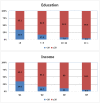Number of remaining teeth and its association with socioeconomic status in South Korean adults: Data from the Korean National Health and Nutrition Examination Survey 2012-2013
- PMID: 29746489
- PMCID: PMC5945020
- DOI: 10.1371/journal.pone.0196594
Number of remaining teeth and its association with socioeconomic status in South Korean adults: Data from the Korean National Health and Nutrition Examination Survey 2012-2013
Abstract
Background: Socioeconomic status (SES) is associated with systemic disease and influences oral and general health. Several studies have found inequalities associated with oral health and SES. We examined the relationship between tooth loss and SES in Korean adults using data from the 2012-2013 Korean National Health and Nutrition Examination Survey. Methods: A total of 7,005 participants were included in this study. Subjects were divided into two groups depending on their total number of natural teeth: <20 and ≥20. Next, participants were divided into quartiles depending on household income and educational level. Multivariate logistic regression was used to obtain odds ratios (OR) for remaining teeth according to income and education levels.
Results: As income and education levels increased, subjects were more likely to have ≥20 remaining teeth (p-value and p-value for trend <0.001), brush their teeth more than three times per day, use extra oral products, and have regular oral-health checkups (all p<0.001). The odds of having ≥20 remaining teeth increased with increases in income and education, after adjusting for all covariates (OR = 1.493 for income Q3, OR = 1.571 for income Q4; OR = 1.763 for 10-12 years education, OR = 2.189 for ≥13years education).
Conclusion: Subjects with higher SES had more remaining teeth than subjects with lower SES. Preserving remaining teeth should be encouraged in subjects with low SES by promoting good oral-health behavior and encouraging more oral-health checkups.
Conflict of interest statement
Figures


References
-
- Tada A, Matsukubo T. Relationship between oral health behaviors and general health behaviors in a Japanese adult population. Journal of public health dentistry. 2003;63(4):250–254. - PubMed
-
- Kim YH, Kim DH, Lim KS, Ko BJ, Han BD, Nam GE, et al. Oral health behaviors and metabolic syndrome: the 2008–2010 Korean National Health and Nutrition Examination Survey. Clinical oral investigations. 2014;18(5):1517–1524. doi: 10.1007/s00784-013-1112-2 - DOI - PubMed
-
- Kobayashi Y, Niu K, Guan L, Momma H, Guo H, Cui Y, et al. Oral health behavior and metabolic syndrome and its components in adults. Journal of dental research. 2012;91(5):479–484. doi: 10.1177/0022034512440707 - DOI - PubMed
-
- Shen T, Lv J, Wang L, Wang W, Zhang D. Association between tooth loss and dementia among older people: a meta-analysis. International journal of geriatric psychiatry. 2016;31(8):953–955. doi: 10.1002/gps.4396 - DOI - PubMed
-
- Nascimento GG, Leite FR, Conceicao DA, Ferrua CP, Singh A, Demarco FF. Is there a relationship between obesity and tooth loss and edentulism? A systematic review and meta-analysis. Obesity reviews: an official journal of the International Association for the Study of Obesity. 2016;17(7):587–598. doi: 10.1111/obr.12418 - DOI - PubMed
Publication types
MeSH terms
LinkOut - more resources
Full Text Sources
Other Literature Sources
Medical
Research Materials

